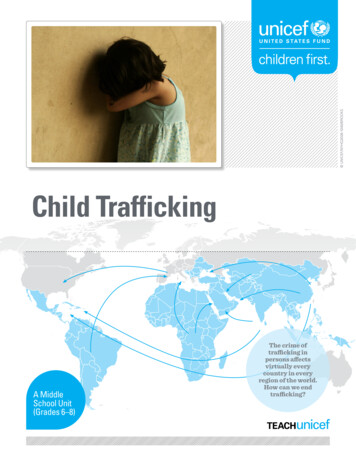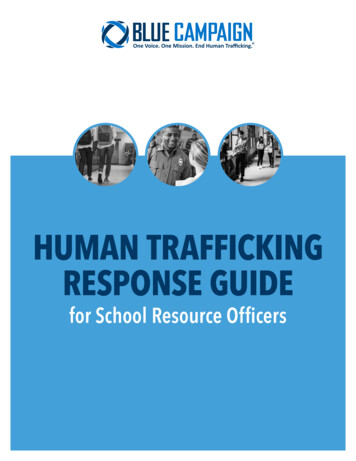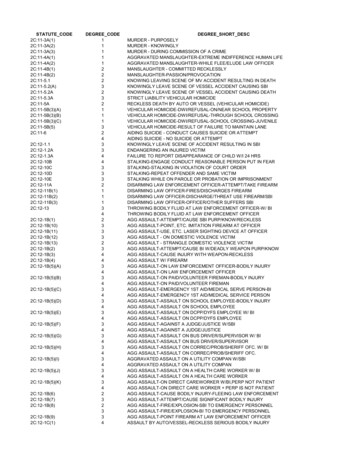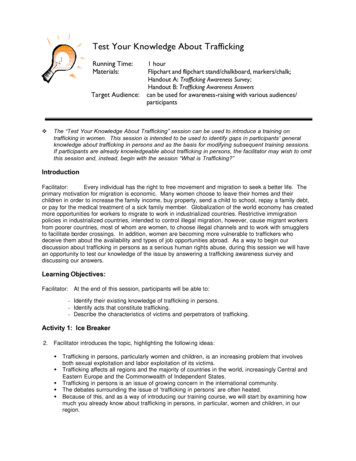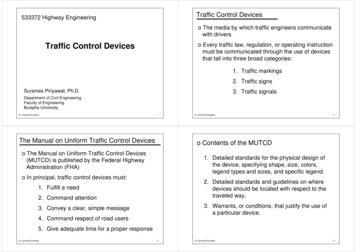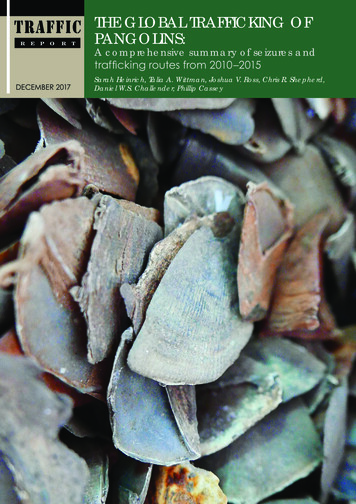
Transcription
TRAFFIC THE GLOBAL TRAFFICKING OFR E P O R TDECEMBER 2017PANGOLINS:A comprehensive summary of seizures andtrafficking routes from 2010–2015Sarah Heinrich, Talia A. Wittman, Joshua V. Ross, Chris R. Shepherd,Daniel W.S. Challender, Phillip CasseyTRAFFIC Report: The Global Trafficking of Pangolins: A Comprehensive summary of seizures and trafficking (2010-2015)1
TRAFFIC REPORTTRAFFIC works closely with its foundingorganizations, IUCN and WWF, making a criticalcontribution to achievement of their conservation goalsthrough a unique partnership.This publication was made possible throughthe support provided by the Office of Forestryand Biodiversity, Bureau for Economic Growth,Education and Environment, U.S. Agency forInternational Development, under the terms of awardnumber AID-AID-EGEE-IO-13-00002: The Wildlife,Trafficking, Response, Assessment, and PrioritySetting Project (Wildlife TRAPS).The opinions expressed in this publication are thoseof the authors and do not necessarily reflect the viewof the U.S. Agency for International Development.Reprod uction of material appearing in this reportrequires written permission fromthe publisher.The designations of geographical entities in thispublication, and the presentation of the material,do not imply the expression of any opinionwhatsoever on the part of TRAFFIC or its supporting organizations con cern ing the legal status of anycountry, territory, or area, or of its authorities,or concerning the delimitation of its frontiers orboundaries.The views of the authors expressed in this publicationare those of the writers and do not necessarily reflectthose of TRAFFIC, WWF or IUCN.Published by TRAFFIC.Southeast Asia Regional OfficeSuite 12A-01, Level 12A, Tower 1,Wisma AmFirst,Jalan Stadium SS 7/15,47301 Kelana Jaya,Selangor, MalaysiaTelephone : (603) 7880 3940Fax : (603) 7882 0171Copyright of material published in this report isvested in TRAFFIC. TRAFFIC 2017.ISBN no: 978-983-3393-76-3UK Registered Charity No. 1076722.Suggested citation: Heinrich, S., Wittman, T.A.,Ross, J.V., Shepherd, C.R., Challender, D.W.S., andCassey, P. (2017). The Global Trafficking of Pangolins:A comprehensive summary of seizures and traffickingroutes from 2010 –2015. TRAFFIC, Southeast AsiaRegional Office, Petaling Jaya, Selangor, Malaysia.Front cover photograph: Seized pangolin scalesCredit: Elizabeth John/TRAFFIC
THE GLOBAL TRAFFICKING OFPANGOLINS:A comprehensive summary of seizuresand trafficking routes from 2010–2015Sarah Heinrich, Talia A.Wittmann, Joshua V. Ross,Chris R. Shepherd, Daniel W.S. Challender, Elizabeth John/TRAFFICPhillip CasseySeized pangolin scales
TABLE OF CONTENTSAbbreviations and AcronymsivAcknowledgementsvExecutive SummaryviIntroduction1Methods4ResultsSeizure summaryInternational traffickingTrafficking 31Supplementary material3526283032
ACRONYMS AND ABBREVIATIONSAEUnited Arab EmiratesBEBelgiumCHSwitzerlandCICôte d’IvoireCITESThe Convention on International Trade in Endangered Species ofWild Fauna and FloraCMCameroonCNChinaCOPConference of the PartiesDEGermanyEIAEnvironmental Investigation AgencyETEthiopiaEU-TWIXEuropean Union Trade in Wildlife Information eXchangeFRFranceGNGuineaGQEquatorial GuineaHKHong Kong Special Administrative Region (SAR)IDIndonesiaINIndiaIUCNInternational Union for Conservation of NatureKEKenyaLALao People’s Democratic Republic (PDR)LRLiberiaMA(CITES) Management ysiaMZMozambiqueNGNigeriaNGONon-governmental OrganizationNLThe NetherlandsNPNepalPHThe UgandaUSThe United States of AmericaVNViet NamivTRAFFIC Report: The Global Trafficking of Pangolins: A Comprehensive summary of seizures and trafficking routes from 2010-2015
ACKNOWLEDGEMENTSThanks are given to the United States Agency for International Development (USAID) for providingpart of the resources to conduct this analysis under the Wildlife Trafficking, Response, Assessmentand Priority Setting (Wildlife-TRAPS) Project. This study was conducted for TRAFFIC, the wildlifetrade monitoring network, and special thanks are given to Lalita Gomez, Boyd Leupen and KanithaKrishnasamy from the Southeast Asia TRAFFIC team for data and support throughout the project.Many thanks to Thomas Prowse (University of Adelaide) for assistance with the visualization ofthe trafficking network, Nick Ahlers and James Compton (TRAFFIC), USAID, and the U.S. Fishand Wildlife Service (USFWS) for helpful comments on the final drafts of the report. We areparticularly grateful to all of the responding Convention on International Trade in EndangeredSpecies of Wild Fauna and Flora (CITES) Management Authorities and non-governmentalorganizations that provided the authors with pangolin seizure information.TRAFFIC Report: The Global Trafficking of Pangolins: A Comprehensive summary of seizures and trafficking routes from 2010-2015v
EXECUTIVE SUMMARYPangolins are currently the most heavily trafficked wild mammals in the world. Their meat isconsidered a delicacy, and has been attributed to have a medicinal/tonic value, their scales are usedin traditional medicines, and pangolin skins are processed into leather products. All eight speciesare listed as threatened on The IUCN Red List of Threatened SpeciesTM. An estimated one millionpangolins have been trafficked in the period 2000–2013, however, there is little understanding ofthe trafficking routes used to transport pangolins globally. In this report, the illegal pangolin tradefrom 2010–2015 was investigated, focusing on the global trade routes used to traffic pangolins andtheir derivatives. A total of 1270 seizure incidents were collated, which included at least 20 749 kgand an additional 7154 individual pangolin body parts, 55 251 kg and an additional 5613 individualpangolin scales, and 44 475 kg and an additional 46 760 individual whole pangolins. This excluded atotal of 7.6% of all incidents where no quantitative information was available. A subset of these data(excluding domestic trade) was used to study international trafficking routes.An average of 33 countries and territories were involved in international pangolin trafficking peryear. Notably, an average of 27 new trade routes were identified each year, highlighting that wildlifetrafficking occurs through a highly mobile trade network with constantly shifting trade routes. Theseizure incidents involved 67 countries and territories across six continents; demonstrating theglobal nature of pangolin trafficking, which is not limited to Asian and African range countries.China and the United States of America (US) were identified as the most common destinations forinternational pangolin trafficking during the six-year period. China was the main destination forlarge-quantity shipments of scales (here defined as shipments involving 1000 kg of scales) andwhole animals (here defined as shipments involving 500 pangolins), while the US was the maindestination for large-quantity shipments of body parts (here defined as shipments involving 100body parts).Europe was identified as an important transit hub, mostly for African pangolins (and their parts andderivatives) being transported to Asia. Germany, France and Belgium were particularly prominent.An exception was the Netherlands, which was reported as a destination for large-quantity shipmentsof body parts and scales from China and Uganda respectively, as well as a common destination forshipments from China.However, most international trafficking of pangolins (and their parts and derivatives) occurredwithin Asia, both in terms of number of incidents and quantity. Of the top ten countries andterritories involved in the most trafficking incidents, seven were in Asia, namely China, Viet Nam,Malaysia, Hong Kong SAR, Thailand, Lao PDR, and Indonesia. The remaining three were the US,Nigeria, and Germany.Body parts (including a variety of raw derivatives or processed commodities, such as skins, trophies,leather products, and medicinals) were significantly more likely to be from an Asian pangolinspecies relative to other commodities in trade and species origins, but the transport mode for bodypart shipments was largely unreported. The analysis of large-quantity shipments indicated that 80%of the trade in body parts was from China and Viet Nam and destined almost exclusively for the US,with the exception of one case, where the Netherlands was the reported destination.Trafficking of scales was significantly more likely to be of African origin and to be transported by air,relative to other transport modes and origins. Analysis of large-quantity shipments involving scalesindicated that 55% of these shipments were of African origin, namely from Cameroon, Nigeria,Sierra Leone, and Uganda. The number of large-quantity shipments of scales, as well as the weightviTRAFFIC Report: The Global Trafficking of Pangolins: A Comprehensive summary of seizures and trafficking routes from 2010-2015
of such shipments, increased significantly through time, as did the number of incidents involvingAfrican pangolin species. China was the main destination for the large-quantity shipments ofscales, but other destinations for these shipments were Hong Kong SAR, the Netherlands, and VietNam.Whole animals were significantly more likely to be transported by land, relative to the othertransport modes and commodities, and large-quantity shipments involving whole animals wereexclusively traded within Asia. Of these large-quantity shipments, Indonesia and Malaysia were themost common origin countries, although Malaysia was also identified as an important destinationand transit country. Other destinations for large-quantity shipments of whole pangolins includedChina, Singapore, Thailand, and Viet Nam.Based on the findings of this study the following recommendations are made, recognizing theunderlying caveats of the seizure data:RECOMMENDATIONSLegislation and enforcement All countries involved in the illegal pangolin trade should review, and amend where necessary,national wildlife laws and relevant Convention on International Trade in Endangered Speciesof Wild Fauna and Flora (CITES)-implementing legislation to protect all eight pangolin speciesfrom trade (see also Challender et al., (2014a), IUCN (2016), and (CITES 2017b)). This shouldinclude full protection for all species of pangolins, native and non-native, within nationalwildlife protection legislation and other legal instruments that govern CITES and internationaltrade. This will provide for a stricter deterrent and provision of higher penalties, given theCITES Appendix I status of all pangolin species (i.e. all commercial international trade of wildcaught specimens is prohibited). Law enforcement agencies (including Customs, police, and relevant wildlife departments) inthe countries identified in this report as implicated in international pangolin trafficking shouldbe vigilant to the persistence of illegal trade. However, the countries that most need to enhancetheir law enforcement efforts are those with low numbers of seizures, but at the same timeimplicated in the routes of many trafficking incidents. According to the presented data, thisdiscrepancy is most notable in (descending order of importance): Lao PDR, Nigeria, Myanmar,Cameroon, Guinea, Mexico, the Philippines, Pakistan, Liberia, Equatorial Guinea, Cote d’Ivoire,Ethiopia, Kenya, Singapore, Mozambique, and Togo. Law enforcement agencies in all countries involved in pangolin trafficking should employintelligence-led investigations to examine, identify, and prosecute all parties involved in thepangolin trade that violates national laws [see also CITES (2017b)], from collectors and traders,to logistics companies and importers, as well as the vendors, purchasers and users of pangolinparts and products. These efforts would be particularly useful in countries and territoriesthat have been involved in large-quantity shipments identified here namely: Cameroon,China, Guinea, Hong Kong SAR, India, Indonesia, Kenya, Lao PDR, Malaysia, Myanmar, theNetherlands, Nigeria, Pakistan, the Philippines, Sierra Leone, Singapore, Thailand, Uganda, theUS, and Viet Nam. Several European countries, especially, Germany, France, and Belgium arealso implicated as they have been identified as important transit hubs, especially for Africanpangolins. Furthermore, analysis of the type of product, and the quantities seized, may beuseful in determining the type of criminal activities and/or networks behind the shipments, andthe enforcement response required.TRAFFIC Report: The Global Trafficking of Pangolins: A Comprehensive summary of seizures and trafficking routes from 2010-2015vii
Profiling through intelligence-led investigations should be employed by source, transit andend-use destinations. The transnational network of illegal pangolin trafficking is highly mobilewith new trade routes emerging every year. Enforcement approaches will need to be equallydynamic and responsive, similar to the methods that been recommended to stem the trade inAfrican ivory and rhino horns to Asia (see e.g. Milliken and Shaw (2012)). Multi-agency collaboration (including Customs, police, wildlife departments, transportationand logistics companies), both at national and international levels, and between source, transitand end-use destinations, should be enhanced to tackle the international and organizedcriminal networks involved in smuggling pangolins across borders. Prosecutors and judiciaries in all pangolin range countries, and non-range countries implicatedin trafficking, should be made aware of all applicable legislation and legal instruments availableto prosecute and convict criminals, as well as the legal and environmental consequences of theillicit pangolin trade, as part of prioritizing attention to wildlife crime [see also CITES (2017b)].This will be imperative to ensure an increase in successful conviction rates, and strongerpenalties, which serve as meaningful deterrents. Zimbabwe is one leading example of thesuccess of this (Shepherd et al., 2016). Forensic techniques to identify the origin of pangolins and their derivatives in trade shouldcontinue to be developed to support law enforcement efforts and investigations into the tradechain [see also Challender et al., (2014a), CITES (2017b)]. Countries making seizures shouldestablish a forensics DNA protocol to ensure pangolin commodities seized can be identifiedto the species level. Such methods should be used more often in future pangolin seizures inorder to assess better the threats to the different species of pangolin; particularly because of apotentially increasing threat to African pangolin species.Monitoring and reporting CITES Management Authorities (MAs) in co-ordination with all relevant enforcement agenciesin all countries involved in the illegal trade in pangolins, their parts and derivatives, shouldimprove reporting of all seizures to the CITES Secretariat as per the new annual illegal tradereporting requirements i.e. CITES Notification 2016/007 (CITES 2016a). Recent changes toCITES reporting requirements (CITES 2016a, 2017a) should be considered and implemented ina standardized way, and data should be made available for statistical analysis and criminologicalresearch, to assist law enforcement and guide ongoing collection of data. Seizure reports,including comprehensive accounts of actions and outcomes, specifics of seizure and prosecutiondetails are needed for analysis of a country’s wildlife trade levels and trends, and, eventually, abetter understanding of the international illegal wildlife trade. Monitoring and reporting on the trafficking of pangolins by CITES MAs, NGOs andindependent researchers should continue, and be expanded to countries where informationon the trade is lacking. Improved monitoring and reporting should be prioritized for: (i)commodity quantities; (ii) the specific roles of countries involved; and (iii) transport modalitiesused in pangolin shipments. Co-operation from transportation and logistics companiesinvolved in movement (however unwittingly) of shipments along trade routes is also necessary;these companies are encouraged to share information on methods of concealment or trafficking,specific routes used, and other notable information to enable effective law enforcementinvestigations. These will assist in gauging levels of illegal trade, detecting emerging trends andinfluencing enforcement, conservation actions and decision-making.viiiTRAFFIC Report: The Global Trafficking of Pangolins: A Comprehensive summary of seizures and trafficking routes from 2010-2015
Demand reduction and awarenessEfforts should be increased to understand and reduce demand for pangolin products tradedillegally in consumer countries, through increased awareness and well-informed and targetedbehavioural change efforts (see also CITES (2017b), Challender et al., (2014a) and IUCN(2016)). Efforts should include an improved analysis of the use of pangolin products beingseized to meet certain types of demand in consumer countries. This would provide furtherinsights into the targeted behaviour change initiatives required based on motivational variationsamongst consumers. Law enforcement agencies, especially those in countries identified as priorities in this study,should ensure officers are aware of the significance and relative prevalence of the illegalpangolin trade, able to recognize pangolin products, and increase their vigilance to detect andintercept shipments (see also Challender et al., (2014a) and CITES (2017b)). While the drivers of trade in Asia are largely known, the demand from priority countriesoutside Asian demand centres (particularly the US and the Netherlands) is poorly understood.Further studies by conservation organizations, research institutions and relevant governmentagencies are required to decipher what is driving the illegal trade into these countries, whatcommodities are being traded, and in what quantities. This will greatly assist in identifyingthe role of non-Asian countries as centres of demand for international pangolin trafficking.Targeted awareness or demand-reduction campaigns may also be warranted. Guangzhou Customs/ www.customs.gov.cn Pangolin scales weighing 136 kg seized at the Guangzhou Customs post offices in 2010.TRAFFIC Report: The Global Trafficking of Pangolins: A Comprehensive summary of seizures and trafficking routes from 2010-2015ix
INTRODUCTIONOverexploitation of wildlife is a major driver of current biodiversity loss (Hoffmann et al., 2010;Maxwell et al., 2016). This includes wildlife trade, both legal and illegal, which is largely regulatedand monitored by the Convention on International Trade in Endangered Species of Wild Faunaand Flora (CITES). Illegal wildlife trade is highly unsustainable in many cases, and has majorimplications for a diverse range of species of animals and plants (Challender et al., 2015b; Phelpsand Webb 2015). It is estimated to be among the most lucrative transnational crimes, alongsidetrafficking in drugs, humans and weapons; and often involves highly organized criminal networks(Wyatt 2013; Nellemann et al., 2016).Pangolins are often cited as currently the most heavily trafficked wild mammals worldwide, withestimates of over one million animals taken from the wild between 2000–2013 (Challender etal., 2014a). All parts of the pangolin’s body, but particularly its scales, are used for a variety ofpurposes in traditional medicines or for ornamentation, their meat is consumed, both as a luxurydish and a local source of protein, and their skins are made into leather products (Bräutigam et al.,1994; Sodeinde and Adedipe 1994; Katuwal et al., 2013; Boakye et al., 2014; Pietersen et al., 2014b;Mohapatra et al., 2015; Soewu and Sodeinde 2015; Shairp et al., 2016). It is widely believed thatpangolin trade is primarily driven by demand in Asian countries, especially China and Viet Nam(Pantel and Chin 2009; Challender 2011; Challender et al., 2014a; Nijman et al., 2016), althoughit has also been shown that demand exists in non-range countries, such as the United States ofAmerica (US), some European countries, and Japan (see e.g. Heinrich et al., (2016)). With declinesin populations of Asian pangolins, there is now evidence of fast-developing intercontinentaltrafficking of African pangolins to Asian markets, facilitated by increasing economic ties betweenEast Asia and many African nations (Challender and Hywood 2012; Challender et al., 2016; Gomezet al., 2016b). Research has also shown an increase in regulated (legal) pangolin trade activityreported to CITES after the year 2000, particularly in African pangolin species, which coincidedwith the establishment of a zero export quota for commercial trade in wild-caught Asian pangolins(Heinrich et al., 2016).Eight extant pangolin species have been described1 (Figure 1) and all are threatened according toThe IUCN Red List of Threatened SpeciesTM—the four African species are listed as Vulnerable(Giant Pangolin Manis gigantea (Waterman et al., 2014a); Ground Pangolin M. temminckii(Pietersen et al., 2014a); Black-bellied Pangolin M. tetradactyla (Waterman et al., 2014b); andWhite-bellied Pangolin M. tricuspis (Waterman et al., 2014c)), whereas the four Asian species arelisted as Critically Endangered (Chinese Pangolin M. pentadactyla (Challender et al., 2014b); andSunda Pangolin, M. javanica (Challender et al., 2014c)), and Endangered (Philippine Pangolin M.culionensis (Lagrada et al., 2014); and Indian Pangolin M. crassicaudata (Baillie et al., 2014)). Inaddition, all pangolins were recently transferred from CITES Appendix II to Appendix I (CITES2016b). This important step provides pangolins with the highest protection status through CITES,and prohibits international trade in wild-caught pangolins for commercial purposes globally.1Note: The nomenclature used in this report follows Wilson and Reeder (2005), aligning with the nomenclature used inCITES and the Catalogue of Life. It is acknowledged that the IUCN Red List and other sources follow Gaudin et al. (2009),placing the species in three genera (Smutsia, Phataginus, and Manis).1TRAFFIC Report: The Global Trafficking of Pangolins: A Comprehensive summary of seizures and trafficking routes from 2010-2015
(a)Manis pentadactylaManis crassicaudataManis culionensisManis javanica(b)Manis tricuspisManis giganteaManis tetradactylaManis temminckiiFigure 1: Species distribution maps of the eight extant pangolin species showing (a) the Asian species(b) the African species. A mix of colours within the maps indicates an overlap in the different species’distributions. The species’ ranges are based on the IUCN Red List assessments (IUCN 2014).Note: The distribution maps are currently being updated by the IUCN Pangolin Specialist Group.TRAFFIC Report: The Global Trafficking of Pangolins: A Comprehensive summary of seizures and trafficking routes from 2010-20152
Pangolin seizure data were collected from a variety of sources. Seizures are an indirect measure ofactual trafficking levels and, across countries, seizure data are likely to be biased by a large numberof complex factors (see also Underwood et al., (2013), and Utermohlen and Baine (2017)). Thesefactors will influence both the “level of enforcement” (i.e. corruption, environmental crime, lack ofawareness) and “level of reporting” (i.e. non-English media, non-compliant enforcement, variationin the in-country activity of non-governmental organization (NGO) agencies). In addition,Customs authorities intercept an unknown percentage of all contraband. Consequently, the seizureincidents reported here are only a proportion of the total number of trafficking incidents worldwide.This is an inherent bias of all seizure data. Masteraah/ Wikimedia CommonsThe purpose of this report is to determine trafficking routes for the illegal transnational pangolintrade and enhance knowledge of where pangolins are sourced from. This information can be usedto understand better where demand exists, which is critically important to inform conservationaction and decision-making, species management, and law enforcement efforts. Despite increasingattention on pangolins globally, a detailed understanding of international trafficking routes usedin the illegal pangolin trade is largely lacking in the existing literature. Some studies have partiallydescribed illegal pangolin trade dynamics, but they have always focussed on specific regions orcountries, and mostly Asia (Challender et al., 2015a; Gomez et al., 2016a; Nijman et al., 2016; Chenget al., 2017; Zhang et al., 2017). To the authors’ knowledge this is the first study to describe theinternational trafficking routes for pangolins on a global scaleA ground pangolin3TRAFFIC Report: The Global Trafficking of Pangolins: A Comprehensive summary of seizures and trafficking routes from 2010-2015
METHODSPangolin seizure data were collated for the period 2010–2015 from a variety of sources, includingonline media reports, openly accessible data from CITES documents from the CITES website(it should be noted that legal pangolin trade reported to CITES has been previously analysed inHeinrich et al., (2016); whereas only illegal incidents were used for this study, hence the legal CITEStrade database was not queried), and from NGO publications, including Education for Nature VietNam (ENV), the TRAFFIC Bulletin, and Last Great Ape Organization (LAGA) annual reports.Additional data were received from the African Pangolin Working Group (APWG; Namibia only)and the EAGLE Network. Datasets previously collated by Dan Challender (data from 2010–2013),and TRAFFIC (2010–2015) were also included. In addition, data were received from Healthmap(www.healthmap.org; 2011–2015) and the Environmental Investigation Agency (EIA; 2010–2015).Data from the European Union Trade in Wildlife Information eXchange (EU-TWIX) database(for data from Europe; 2010–2015) were included, as well as data from the Law EnforcementManagement Information System (LEMIS; 2010–2014) for the US.Seizure data were requested from 179 CITES Management Authorities (CITES MAs). Data requeststo the CITES MAs were sent via email in September 2016 and, where no initial response wasreceived, a follow up request was sent in October 2016 (with the exception of Syria). Four MAswere not contacted: the European Union was not contacted as all member countries were contactedindividually; Panama and Tonga could not be contacted with the details provided on the CITESwebpage, nor through the relevant national departmental webpages; and Liechtenstein was notcontacted as it shares a Customs union with Switzerland. New Zealand provided data (from 2010–2016, 67 seizure incidents), but were unable to assign any of the incidents to specific years, and wereexcluded from further analysis. Furthermore, while Hong Kong Special Administrative Region(SAR) is a territory of China, data are provided separately through their respective CITES MAs, andtherefore data from each source has been kept separate for the purpose of this study. Reference toChina in the Results and Discussion sections of this study is to mainland China only and does notinclude data from Hong Kong SAR, Macao SAR, nor Taiwan.All available seizure data were collated into a bespoke SQL database (Microsoft Access). The datawere collected based on seizure events pertaining to a particular seizure location, hereafter referredto as an “incident”. Information collected for each incident included, but was not limited to: (i)location and date of seizure; (ii) species, commodities and quantities seized; (iii) transport mode;and (iv) trade route information (i.e. links between origin, transit and destination countries orterritories), where available. In some cases an incident consisted of more than one trade route (e.g.when more than one origin or destination location were reported, i.e. if a shipment of pangolins wasseized in an Asian country or territory, but the commodities that made up the shipment originatedfrom two different African countries). When curating the trade route information for each incident,an “origin country” was defined as the first known point, and a “destination country” as the lastknown point in any trade route. All reported countries and territories in-between were designatedas transit countries. The country or territory of seizure could occur at any point along the traderoute, and could be an origin, transit or destination country or territory, as reported.All data were subset to only include: (i) verified incidents (i.e. those that were either provided byrestricted access sources or where open access sources could be independently verified online); and(ii) international incidents (i.e. trade routes crossing at least one international border, and excludingall domestic trade links). It is acknowledged that this potentially precludes incidents that weresupposed to be exported but were intercepted before reportedly crossing an international border.TRAFFIC Report: The Global Trafficking of Pangolins: A Comprehensive summary of seizures and trafficking routes from 2010-20154
Commodities were grouped into three categories, namely: (i) “Scales” (including only scales); (ii)“Whole animals” (including whole animals that were either live, dead, or whole but uncertain oftheir condition); and (iii) “Body Parts” (including all other commodities and medicinals, i.e. legs,claws, skins, and undefined raw or processed products). Three rules were constructed in orderto assign a home continent (Africa or Asia) to the pangolins traded. First, if the pangolin specieswas reported in the incident, it was assigned its respective native home continent; secondly, ifthe commodity source country or territory was reported (this being the actual source countryor territory where the trafficked pangolins origin
THE GLOBAL TRAFFICKING OF . PANGOLINS: A comprehensive summary of seizures. and trafficking routes from 2010-2015. Sarah Heinrich, Talia A.Wittmann, Joshua V. Ross,


